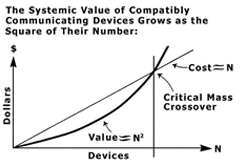To Really Live, Learn and Thrive in Social Media
You Need to Understand When 2 + 3 = 25
How does a business gain critical mass in their social media network and get a return on investment? Let’s start with understanding social media beginnings. In a recent interview¹ with Jonathan Gourlay at the Monadnock Ledger –Transcript, we talked about Social Media, when it began and how it relates to business. In electronic media there were listservs where professionals could easily interact in a group discussion via email. Then there were online forums where communities could discuss the topics of the day.
Really the change from traditional to social media occurred when communication was not just broadcast or printed for many individuals to hear or read. It started when the audience could interact with the originator of the content. When that happened we went from a one-way to a two-way conversation. Talk radio was therefore an early form of social media. But the real power in social media occurs when communications go beyond just two people and many people are added to the conversation.
The leading networks in this digital age where you can build your network of followers, fans, and connections are Twitter, Facebook, LinkedIn and YouTube. Although more than 133,000,000 blogs have been indexed by Technorati since 2002, blogs are only a form of social media when people begin to comment and interact with each other. Without the comments it is still a traditional form of media communication.
Metcalfe’s Law Applied to Social Media
You might be asking “so when does 2 + 3 = 25?” Here’s where a scientific principle called Metcalfe’s Law comes into play. Metcalfe’s Law states:
“the value of a network increases proportionately with the square of the number of its users.”²
When you apply that law to social media networks, you can see that although 2+3=5, with Metcalfe’s Law the real power of the network is greater. In fact it is 5², or 5 x 5, which equals 25. Now you should consider, when does the cost of time and money spent on social media to expand your network give you a return on your investment? How can you get the value of your network to go from 5 to 25?
Engagement Increases Impact and Influence
To really live, learn and thrive in social media you need to do more than add more friends, fans or followers. The value potential of Metcalfe’s Law can only be fully realized if you interact with your audience and keep your communications authentic, consistent and relevant.
If your friends, fans, followers are not engaged, the impact or influence of your network is diminished. If they are engaged, the value of your network will grow exponentially. Of course, as in all business, you must start with a good product or service.
Metcalfe’s original point was to establish the existence of a cost-value crossover point–critical mass–before which networks don’t pay. Should you get involved with social media. I would say yes. The choices that have to be made are which networks, how much time, how much money.
Remember to create a strategy for your social media marketing with measurable results so you don’t spend time and money, without knowing your return on that investment.
¹ “Getting Social” by Jonathan Gourlay, Monadnock Ledger-Transcript.
²"Metcalfe’s Law: more misunderstood than wrong?” by Simeon Simeonov















[…] This post was mentioned on Twitter by Consensus-Technology, Barbara O'Connell. Barbara O'Connell said: RT @consensustechno: If you want to break the code and understand more about being successful in social media…. http://fb.me/KWMjpOjC […]